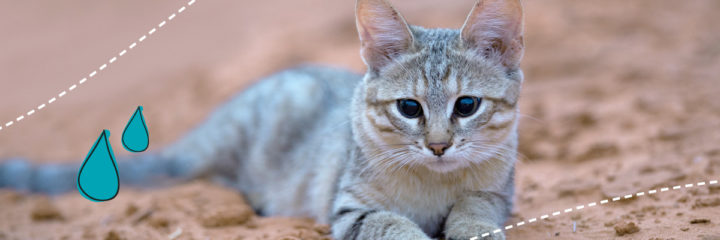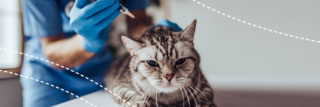
SUMMARY
- Due to its origin, the cat is used to get along with little water
- DehydrationA deficit of total body water. Dehydration can be caused by excessive fluid loss, for instance via the kidneys in CKD, or by insufficient fluid intake.... increases the amount of uraemic toxinsToxic, nitrogen-containing urinary substances responsible for uraemia and kidney damage.... in the blood
- With CKD, managing the water balance of the cat is essential
*Advertisement, as brand name mentioned
CATS ARE DESERT ANIMALS
Our domestic cats are of African-Egyptian origin. As desert animals they are used to get along with little water. Their bodies have adapted to the low water supply: cats can regain water via the intestines and kidneys. This can lead to highly concentrated urine and solid faeces. At the same time, cats hardly sweat at all. Instead, they regulate their body temperature by the air they breathe. Our domestic cats have retained these physiological characteristics.
While the adult domestic cat needs only 50ml of fluid per kilogram of body weight per day, feral cats can go several months without drinking. They subsist on the liquid contained in the prey they eat.
KIDNEYS AS “WATERPOWER STATIONS”
However, if the cats’ body lacks water, dehydration occurs. The blood can then become thicker and the haematocrit can rise. As a result, the cats’ kidneys increasingly try to regain water. This in turn can lead to an increase in the blood value of ureaUrea is the nitrogen-containing breakdown product of protein metabolism. The nitrogen from the proteins is converted to ammonia in the liver, which is combined with carbon dioxide to form urea. This is continuously excreted via the kidneys but also via sweat. Urea is one of..., as urea is increasingly recovered during this compensation process. In addition, the kidney toxins (uraemic toxins) in the blood must continue to be excreted by the kidneys through the urine. However, if the level of fluid in the blood decreases, the concentration of renal toxins increases and with it their harmful effect on the cat’s body.

MASTER OF FILTRATION = NEPHRONS
The filter units, the so-called nephronsNephrone sind die Filtereinheiten der Nieren...., are responsible for urine production. Shortly after birth, all nephrons that the cat needs on its path through life are already developed. The number of nephrons is limited because no additional nephrons are built up. The kidneys of the cat each contain about 200,000 of these filter units. This sounds like a lot, but compared to dogs and humans it is rather few.
Not every nephron is active from the beginning. What remains are so-called reserve nephrons, which are only used when other nephrons are no longer functional. This happens over and over again, because nephrons cannot regenerate. If one nephron is impaired, a new nephron takes over. This continues until all reserve nephrons are in use. If this is the case, the remaining nephrons can additionally increase their work output if further filter units fail, in order to replace the work of the failed nephrons. This compensation has its limits, because if the remaining nephrons are permanently overburdened, they also fail, so that the overall kidney performance decreases. This is especially the case when cats are old.
Each nephron works independently of the others and can produce urine. If more than 70% of the working nephrons are damaged, the kidneys’ ability to excrete is significantly reduced and toxins (uraemic toxins) remain in the body. The vicious circle of self-destruction of the kidneys then takes its course in chronic cat kidney disease (CKD).
Let the water flow: drought despite excessive water absorption
Often, cat owners are initially happy because their cat “finally” drinks a lot. But in reality, this is excessive drinking (polydipsiaExcessive thirst due to illness, leading to excessive production of urine (polyuria)....) combined with excessive urine loss (polyuriaExcessive production of urine, potentially due to kidney failure....). Both are signs of kidney problems. This is the trouble: on the one hand it is positive if the cat drinks a lot of fluids, on the other hand it can be a sign of kidney disease (CKD).
With CKD, the cat loses more and more water through the urine because the few remaining filter units (nephrons) cannot recover enough water. This results in the cat’s body dehydrating. The cat drinks and drinks and loses even more water through the urine. It sounds like a paradox, but the cat dehydrates more and more, even though it is drinking a lot.
The waterpower stations have then opened all their gates and can no longer hold back the water. This is particularly the case in IRIS stages 3 and 4.
WATER MANAGEMENT
In CKD, managing the cat’s water balance is essential, also to maintain the cat’s quality of life. As mentioned above, the amount of fluid present in the cat’s body also affects blood quality. For good blood flow to the kidneys, which influences the oxygen requirement of the kidneys themselves and therefore their performance, the cat must have sufficient fluid in its body. To achieve this, it is beneficial if the cat consumes as much liquid as possible on its own.
The water provided should be fresh and of good quality. It should be offered to the cat in such a way that its water intake is positively stimulated (with a few drops of tuna oil, in special drinking fountains, wet food with additional water, etc.).
Unfortunately, in the course of the CKD, voluntary water uptake decreases despite increasing water loss through urine, and many cats then have to be infused or receive water depots under the skin (so-called subcutaneous fluid therapy).
It is therefore essential that the kidneys have sufficient fluid available to perform their various excretory tasks.
Especially in old age, cats need to drink sufficiently.
Read more about uraemic toxins in my blog post.
Bibliography:
-
-
- Galtzmeier, C. (2019): Die akute und chronische Niereninsuffizienz bei der Katze – Ein Handbuch für Besitzer nierenkranker Katzen. Amazon Fulfillment, Wroclaw, Polen.
- Sparks, A. H. / Caney, S. / Challhoub, S. / Elliot, J. / Finch, N. / Gajanayake, I. / Langston, V. / Lefebvre, H. / White, J. & Quimby, J. (2016): ISFM Consensus Guidelines on the Diagnosis and Management of Feline Chronic Kidney Diseases; In: Journal of Feline Medicine and Surgery (18), S. 219 –239.
-


